
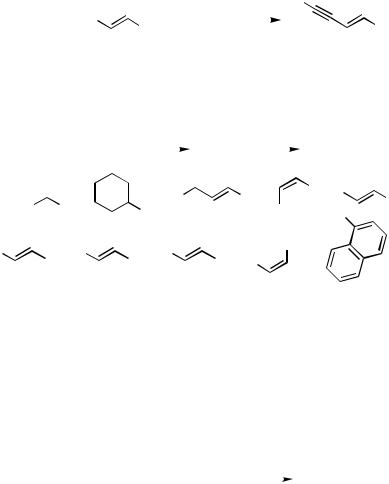
III.2.4 OVERVIEW OF OTHER Pd-CATALYZED CROSS-COUPLING PROTOCOLS |
295 |
B.iii. Alkynylsilane
Alkynyl(trimethyl)silanes smoothly couple with alkenyl halides at room temperature in the presence of a palladium catalyst and TASF (Scheme 20).[13] The difference in reactivity between alkynylstannanes and -silanes was utilized in a Pd-catalyzed threecomponent cross-coupling reaction. Thus, the Pd-catalyzed sequential reaction of tributylstannyl(trimethylsilyl)ethyne first with an alkenyl halide and second with another alkenyl or aryl iodide in the presence of newly added TASF afforded conjugated dienynes or arylenynes (Scheme 21).[24]
|
|
|
|
|
|
|
|
|
|
|
|
|
|
2.5% [PdCl(η3-C3H5)]2 R |
|||||
|
|
|
|
|
|
|
|
|
|
|
Br |
TASF (1.3 equiv) |
|||||||
R |
|
|
|
|
|
SiMe3 |
+ |
|
|
|
|
|
|
||||||
|
|
|
|
|
|
|
|
|
|
|
|||||||||
|
|
|
|
|
THF, r.t. |
||||||||||||||
|
|
|
|
|
|
|
|
|
|
|
|
|
Ph |
||||||
R = Ph, n-Pent, HOCH2 |
|
|
|
|
|
|
|
|
|
||||||||||
|
|
|
|
|
|
|
|
|
|
|
|
|
Scheme 20 |
|
|
|
|||
|
|
|
|
|
|
|
|
|
|
|
|
5% Pd(PPh3)4 |
|
|
|
R2−I (1.0 mol) |
|||
Bu3Sn |
|
|
|
|
|
|
SiMe3 |
|
R1−I (1.0 mol) |
|
|
|
TASF (2.4 mol) |
||||||
|
|
|
|
|
|
|
|
|
|
|
|
|
|
|
|||||
|
|
|
|
|
|
|
THF, 50 °C |
|
|
|
|
|
|
||||||
|
|
|
|
|
|
|
|
|
|
|
|||||||||
|
|
|
(0.8 mol) |
|
|
|
|
|
|
|
|
||||||||
|
|
|
|
|
|
|
|
|
|
|
|
|
|||||||
R1−I |
|
|
|
|
|
|
|
|
|
|
AcO |
I |
|||||||
|
|
|
|
|
|
|
|
|
|
||||||||||
|
|
|
|
|
|
|
|
|
|
||||||||||
n-Bu |
I |
|
|||||||||||||||||
|
|
||||||||||||||||||
|
|
|
|
|
I |
|
|
|
n-Hex |
||||||||||
|
|
|
|
|
|
|
|
|
|
|
|
|
|
|
|
|
|
|
|
Ph
83−86%
R1 R2
R2
I n-Pr
I
I
R2−I I |
n-Hex I |
|
I |
n-Oct |
|
n-Hex |
n-Pr I |
|
|||
|
80% |
72% |
58% |
70% |
63% |
|
|
Scheme 21 |
|
|
|
A catalytic amount of CuCl was found to also activate alkynyltrimethylsilanes in the Pd-catalyzed coupling reaction with aryl and alkenyl triflates (Scheme 22).[25] The catalytic cycle is considered to involve the transfer of an alkynyl group from an alkynylsilane to Cu(I), then to Pd(II). A sequential Pd-catalyzed reaction of trimethylsilylacetylene gives unsymmetrical diarylacetylenes (Scheme 23).
|
|
|
|
|
2.5% Pd(PPh3)4 |
R1 |
|
|
|
SiMe3 + TfO−R2 |
10% CuCl |
|
|
|
|
||
|
|
|
DMF, 80 °C, 3−24 h |
||
|
|
|
|||
|
|
|
|
|
R1 = Ph
4-NC-C6H4
4-MeO-C6H4
2-thienyl
4-TBSO-C6H4
R2 = 4-MeCO-C6H4 4-NC-C6H4 4-t-Bu-cyclohexen-1-yl
Scheme 22
R1 R2
R2
51−90%
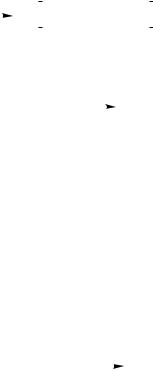
296 III |
Pd-CATALYZED CROSS-COUPLING |
|
|
|
|
|
|
|
|
|
|
|
|
|
||||
|
|
|
|
|
R1−OTf |
|
|
|
|
|
|
|
|
|
|
|
|
|
|
|
|
|
|
2.5% Pd(PPh3)4 |
|
|
|
|
|
|
|
|
|
|
|
|
|
H |
|
|
|
SiMe3 |
Et3N |
|
R1 |
|
|
|
|
SiMe3 |
|
|
|
|
||
|
|
|
|
|
|
|
|
|
|
|
|
|||||||
|
|
|
|
|
|
|
|
|
|
|
|
|
||||||
|
|
|
DMF, 60 °C, 6 h |
|
|
|
|
|
|
|
|
|
||||||
|
|
|
|
|
|
|
|
|||||||||||
|
|
|
|
|
|
|
R2−OTf |
|
|
|
|
|
|
|||||
R1 = 4-MeCO-C6H4, R2 = 4-NC-C6H4 |
|
|
|
|
|
|
|
|
||||||||||
94% |
|
10% CuCl |
R1 |
|
|
|
|
R2 |
||||||||||
|
|
|
|
|
|
|
|
|
|
|||||||||
R1 = 4-MeO-C6H4, R2 = 4-NC-C6H4 |
94% |
|
80 °C, 12 h |
|
|
|
|
|||||||||||
|
|
|
|
|
||||||||||||||
|
|
|
|
|
|
|
||||||||||||
Scheme 23
B.iv. Alkylsilane
Pentacoordinated silicate TASF, one of the best activators of organosilicon compounds in the Pd-catalyzed cross-coupling reaction as we have seen, is found to be involved in the coupling reaction with aryl halides in the absence of other organosilanes to give methylated arenes (Scheme 24).[26] Recently, DeShong and co-workers also reported that tetrabutylammonium triphenyldifluorosilicate, another pentacoordinated silicate, is applicable for the phenylation of allyl benzoates[27] and aryl halides[28] in the presence of a palladium catalyst.
|
|
1.3% [PdCl(η3-C3H5)]2 |
|
(Et2N)3S+ (Me3SiF2)− |
I−Ar |
|
Me−Ar |
|
|||
|
|
THF, 50 °C, 20 h |
|
TASF |
|
59−86% |
|
Ar = 1-Np |
|
|
|
|
|
2-Np |
|
|
4-MeCO-C6H4 (bromide) |
|
|
4-NO2-C6H4 |
|
|
4-MeOCO-C6H4 |
|
|
3-MeOCO-C6H4 |
|
|
3-MeCOOCH2-C6H4 |
|
|
Scheme 24 |
|
Alkylsilanes activated in situ by TBAF are also applicable to the cross-coupling reaction with aryl halides (Scheme 25).[29],[30] The fact that the reaction requires excess amount of a fluoride ion for giving products in acceptable yields is ascribed to the trapping of the fluoride ion by coproduced SiF4, which is converted into (SiF5) or (SiF6)2 .
The cross-coupling reaction of an optically active alkylsilane gives us valuable information on the stereochemistry in transmetallation.[31] The reaction of (S)-1-phenyl-1- (trifluorosilyl)ethane (34% ee) with 4-acetylphenyl triflate in the presence of 5 mol % of Pd(PPh3)4 and TBAF (2 equiv) at 50 °C gave (S)-1-phenyl-1-(4-acetylphenyl)ethane of 33% ee with nearly complete retention of configuration. At higher temperatures, ee of the product decreased linearly, and above 75 °C inversion of configuration predominated (Scheme 26). Similar temperature dependency was observed also in the reaction of 3-formylphenyl triflate.

III.2.4 OVERVIEW OF OTHER Pd-CATALYZED CROSS-COUPLING PROTOCOLS |
297 |
|
|
5% Pd(PPh3)4 |
|
|
||
Y−(CH2)n−SiF3 |
+ X−Ar |
TBAF (4 equiv) |
||||
|
|
|
|
|||
THF, 100 |
°C, 8 |
−48 h |
||||
|
|
|||||
Y = H |
Ar = 4-MeCO-C6H4 |
|
|
|
||
Ph |
4-HCO-C6H4 |
|
|
|
||
CO2R |
4-NO2-C6H4 |
|
|
|
||
COMe |
2-Np |
|
|
|
||
CN |
Ph |
|
|
|
||
2 n 6 |
4-Me-C6H4 |
|
|
|
||
2-NO2-C6H4 |
|
|
|
|||
3-quinolinyl
5-MeOCO-fur-2-yl X = I, Br
Scheme 25
Y−(CH2)n−Ar
32−87%
|
Me |
|
|
|
|
|
|
|
|
Me |
|
|
|
|
TfO |
|
|
|
5% Pd(PPh3)4 |
|
|
|
|
|
|
||
|
SiF3 |
|
|
|
TBAF (4 equiv) |
|
|
|
|
|
|
||
|
|
|
|
|
|
|
|
|
|
||||
|
+ |
|
|
|
|
|
|
|
|
|
|
|
|
|
|
|
|
|
|
|
|
|
|
|
|
|
|
|
R−SiF3 |
|
|
COMe |
|
|
|
|
|
|
COMe |
||
|
|
|
|
|
|
|
|
|
|
|
|
|
|
from (S)-R−SiF3 of 34% ee |
|
|
|
|
|
|
|
|
|
|
|||
Temperature (°C) |
50 |
|
60 |
70 |
80 |
90 |
100 |
in THF |
|||||
|
|
|
|
|
|
|
|
|
|
|
|
||
% ee (Configuration) |
33 (S) |
23 (S) |
10 (S) |
7 (R) |
18 (R) |
20 (R) |
|
|
|||||
from (S)-R−SiF3 of 38% ee |
DMF−THF DMSO−THF |
HMPA−THF |
|
||||||||||
Solvent |
THF |
|
|||||||||||
|
|
|
|
(1:10) |
(1:10) |
|
(1:10) |
at 60 |
°C |
||||
% ee (Configuration) 23 (S) |
16 (S ) |
16 (S) |
|
|
8 (R) |
||||||||
|
|
|
|
||||||||||
Scheme 26
The stereochemistry is also affected by the solvent polarity (Scheme 26). The reaction using (S)-1-phenyl-1-(trifluorosilyl)ethane of 38% ee at 60 °C resulted in retention (23% ee, S) in THF, but inversion (8% ee, R) in HMPA – THF (1:10). Higher temperature and polar solvents are considered to change the reaction mechanism of transmetallation from a four-centered transition state [SE2 (cyclic)] to a backside attack of the palladium(II) complex [SE2 (open)] (Scheme 27).
F |
|
− |
|
|
|
|
− |
||
|
Pd(Ar)Ln |
F4Si |
||
|
Ph |
|||
F4Si |
Ph |
|
F |
|
Me |
H |
|
||
|
|
|
||
Me |
H |
|
|
Pd(Ar)Ln |
retention |
|
inversion |
||
|
|
Scheme 27 |
|
|
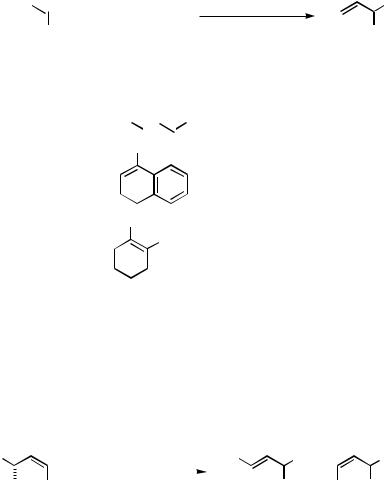
298 |
III Pd-CATALYZED CROSS-COUPLING |
B.v. Allylsilane
Allyltrifluorosilanes undergo the cross-coupling reaction with aryl halides, an allyl acetate, or alkenyl triflates exclusively at the -carbon to give allylated products (Scheme 28).[32] The -selectivity is noteworthy, because the cross-coupling reaction using other allylmetals usually takes place via -attack.
F3Si
 R1
R1
R2
R1 = R2 = H
R1 = Me, R2 = H
R1 = R2 = Me
2−5% Pd(PPh3)4 or
5% Pd(OAc)2/10% dppb TBAF (1.0−1.5 equiv) or TASF (1.0 equiv)
+ X−R3
THF, 80−100 °C, 5− 46 h
4-MeCO-C6H4-I 2-NH2-C6H4-I 2-Br-C6H4-I 4-MeCO-C6H4-OTf 3-MeO-C6H4-I
AcO  Ph
Ph
R1
 R3
R3
R2
51−98%
OTf
OTf
CO2Et
Scheme 28
The reaction of optically active allyl(difluoro)phenylsilanes with aryl triflates affords optically active allylarenes with high stereoselectivities, wherein the absolute configuration of the newly generated chiral carbon can be controlled by the choice of a fluoride salt and the solvent polarity (Scheme 29).[33] Aryl and alkenyl triflates are effective coupling partners not only for allylsilanes but also for alkenyl-, aryl-, alkyl-, and alkynylsilanes[34] as we have been seen in some examples of the preceding sections.
R |
|
|
|
|
R |
Me |
Me |
|
+ TfO-2-Np |
5% Pd(PPh3)4 |
|
|
+ |
||
|
|
°C, 30 h |
|
||||
PhF2Si |
Me |
60 |
2-Np |
R 2-Np |
|||
|
|
|
|
||||
|
|
R |
Stereoselectivity |
E/Z |
Yield (%) |
||
TASF (4 equiv), DMF |
Me |
99% invension |
8.6 |
70 |
|||
CsF (4 equiv), THF |
Et |
74% retention |
42 |
50 |
|||
|
|
|
|
Scheme 29 |
|
|
|
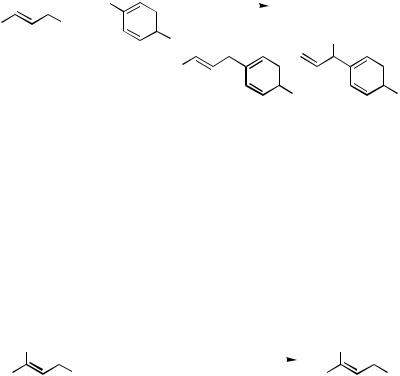
III.2.4 OVERVIEW OF OTHER Pd-CATALYZED CROSS-COUPLING PROTOCOLS |
299 |
Bisphosphine ligands having a certain bite angle, however, change the regioselectivity of allylsilane coupling from - to -carbon (Scheme 30).[35] Retardation of a reductive elimination step by use of a dppe or dppp ligand is assumed, and this is considered to induce isomerization of the secondary ( )-allyl in an allyl(aryl)Pd(II) complex to a primary -allyl complex. The -selective reaction was applied to various aryl bromides or triflates (Scheme 31).
|
|
|
|
|
|
|
5% PdCl2L |
|
|
|
|
|
|
|
|
|
|
|
|
|
|
|
5% L |
|
|
|
|
|
|
|
|
|
|
Br |
|
|
|
|
TBAF (3 equiv) |
|
|
|
|
|
|
|
|
|
|
|
|
|
|
|
|
|
|
|
|
|
|
|
|
|
|
|
|
|
THF, 120 °C |
|
|
|
|
|
|
|
|||
Me |
|
SiF3 + |
|
|
Ac |
|
|
|
|
|
Me |
|
|||
|
|
|
|
|
|
|
|
||||||||
|
|
|
|
|
|
|
|
|
|
|
|||||
|
|
|
|
|
|
|
|
|
|
||||||
|
|
|
|
|
|
|
|
|
|
|
|
|
|||
|
|
|
|
|
Me |
|
|
|
|
|
+ |
|
|
|
|
|
|
|
|
|
|
|
|
|
|
|
|
|
|||
|
|
|
|
|
|
|
|
|
|
|
|
|
|
||
|
|
|
|
|
|
|
|
|
|
|
|
|
|||
|
|
|
|
|
|
|
α |
|
|
|
Ac |
γ |
Ac |
||
|
|
L |
|
Time (h) |
|
Yield (%) |
|
|
α : γ |
E/Z in α |
|
||||
|
|
|
|
|
|
|
|
|
|
|
|||||
|
|
Ph2PCH2PPh2 |
|
23 |
85 |
|
55:45 |
4.6:1 |
|
|
|||||
|
|
Ph2P(CH2)2PPh2 |
18 |
86 |
|
97:1 |
8.1:1 |
|
|
||||||
|
|
Ph2P(CH2)3PPh2 |
15 |
92 |
|
99:1 |
7.2:1 |
|
|
||||||
|
|
Ph2P(CH2)4PPh2 |
6 |
57 |
|
16:84 |
4.3:1 |
|
|
||||||
|
|
Ph2P(CH2)5PPh2 |
41 |
77 |
|
6:94 |
4.8:1 |
|
|
||||||
|
|
Ph3P |
|
12 |
97 |
|
0:100 |
— |
|
||||||
|
|
|
|
|
Scheme 30 |
|
|
|
|
|
|
|
|||
|
|
|
|
|
|
5% PdCl2(dppp) |
|
|
|
|
|
|
|
||
|
R |
|
|
|
5% dppp |
|
|
|
|
R |
|
||||
|
− |
TBAF (3 equiv) |
|
|
|
|
|
||||||||
|
|
|
|
|
|
|
|
|
|
|
|
|
|||
|
|
+ X |
|
Ar |
THF, 120 °C, 12 |
−50 h Me |
|
|
|
||||||
Me |
|
SiF3 |
|
|
|
|
|
Ar |
|||||||
|
R = H, Me |
|
|
|
|
|
|
|
|
|
|
49−100% |
|
||
Ar = 4-MeCO-C6H4 4-NC-C6H4 2-MeO-C6H4 4-MeOCO-C6H4
X = Br, OTf
Scheme 31
The kind of fluoride ion activator and the leaving group in electrophiles affect the stereochemistry in the cross-coupling reaction of allylsilanes as exemplified with 2-cyclo- hexenyl(difluoro)phenylsilane (Scheme 32).[36]

300 |
|
III |
Pd-CATALYZED CROSS-COUPLING |
|
|
|
|
|
|
|
|||||||
|
|
|
|
|
|
|
|
|
|
5% Pd(PPh3)4 |
|
|
|
|
|
||
|
|
|
|
SiF2Ph + X |
|
|
|
|
F− (2 equiv) |
|
|
|
|
|
|
||
|
|
|
|
|
|
|
O 90 °C |
|
|
|
|
|
|
O |
|||
|
|
|
|
64% ee |
|
|
|
|
|
|
|
|
|
|
|||
|
|
|
|
|
|
|
|
|
|
|
|
|
|
||||
|
|
|
|
|
|
|
|
|
|
|
|
|
|
Chirality |
|||
|
|
|
|
F− |
|
|
|
|
|
|
|
|
|
|
|||
|
X |
Solvent |
Time (h) |
Yield (%) |
% ee (Configuration) |
Transfer (%) |
|||||||||||
|
I |
TBAF |
THF |
3 |
84 |
52 |
(S) |
81 |
(ret) |
||||||||
|
I |
CsF |
THF |
108 |
39 |
22 |
(S) |
34 |
(ret) |
||||||||
|
OTf |
TBAF |
THF |
51 |
90 |
5 |
(S) |
8 |
(ret) |
||||||||
|
OTf |
CsF |
CH2Cl2 |
21 |
17 |
24 |
(R) |
38 |
(inv) |
||||||||
Scheme 32
B.vi. Synthetic Applications
The Pd-catalyzed cross-coupling reaction of organosilicon compounds is applied to the synthesis of biologically active compounds. Some examples are described in the following schemes: artificial HMG–CoA reductase inhibitor, NK-104 (Scheme 33)[37]–[39]; a precursor of a DNA topoisomerase inhibitor (Scheme 34);[40] and nucleosides (Scheme 35).[41]
Me2ClSiH (1.2 equiv)
0.5% t-Bu3P • Pt(CH2=CHSiMe2)2O
O |
O |
|
|
|
|
|
|
|
O |
|
O |
||||||
|
|
r.t., 1 h |
|
|
|||||||||||||
|
|
|
|
|
|
|
|
|
|
|
|
|
|
|
|
||
|
|
|
|
CO2t-Bu |
|
ClMe2Si |
|
|
|
||||||||
|
|
|
|
|
Ar−I (1.0 equiv) |
|
|
|
|
||||||||
H |
|
|
|
|
|
|
|
|
|
|
|
|
|||||
|
|
|
|
|
2.5% [PdCl(η3-C3H5)]2 |
|
|
O |
O |
||||||||
|
|
|
|
|
TBAF (2.0 equiv) |
|
|
|
|||||||||
|
|
|
|
|
|
|
|
|
|
|
|
|
|
||||
|
|
|
|
|
|
|
|
|
|
|
|
|
|
|
|
|
|
|
|
|
|
|
THF, 60 °C, 0.5 h |
|
Ar |
80% (2 steps) |
|||||||||
|
|
|
|
|
|
|
|
|
|
|
|||||||
|
|
|
|
|
|
O |
|
|
F |
|
|
|
|||||
|
|
|
|
|
|
|
|
|
|
|
|
|
|
|
|
|
|
|
|
|
|
|
|
|
|
|
|
|
|
|
|
|
|
|
|
|
|
|
|
|
|
O |
|
|
|
|
|
|
|
|
|
||
|
|
|
|
|
|
|
|
|
|
|
|
|
|
|
|||
CF3CO2H (15 equiv) |
|
|
Ar−I = |
|
|
|
|||||||||||
CH2Cl2, r.t., 16 h |
|
|
Ar |
OH |
|
|
|
|
|||||||||
NK-104
67%
 CO2t-Bu
CO2t-Bu
CO2t-Bu
I
N
Scheme 33
MeO |
I |
MeO |
|
|
5% [PdCl(η3-C3H5)]2 |
|
|||||||||
O |
|
10% P(OEt)3 |
|
||||||||||||
|
|
|
|
|
|
||||||||||
|
|
+ |
MeO |
|
|
TBAF (1.2 equiv) |
|
||||||||
MeO |
CO2Me (EtO)Me2Si |
O |
|
THF, 60 °C, 2 h |
|
||||||||||
MeO |
|
|
O |
MeO |
O |
||||||||||
MeO |
|
|
|
|
|
|
|
MeO |
|
|
|||||
MeO |
|
|
|
|
|
|
|
MeO |
|
|
|
|
|
O |
|
|
|
O |
|
|
|
|
|
||||||||
|
|
|
|
|
|
|
|
|
|
||||||
|
|
CO2Me |
|
|
|
|
|
|
|
|
|
NMe |
|
||
MeO |
|
|
|
|
|
MeO |
|
||||||||
|
|
|
|
|
|
|
|
|
|
|
|||||
|
|
76% |
|
|
|
|
|
|
|
|
|
|
|
|
|
|
|
|
|
|
|
|
|
|
O |
|
|||||
Scheme 34

III.2.4 |
OVERVIEW OF OTHER Pd-CATALYZED CROSS-COUPLING PROTOCOLS |
301 |
|||||||||||||||||||
|
|
|
|
|
|
|
|
|
|
|
|
|
|
O |
|
||||||
|
|
|
|
|
|
|
|
MeO |
|
|
O |
|
|||||||||
|
|
|
|
|
|
|
|
|
|
||||||||||||
|
|
|
|
|
|
|
|
|
|||||||||||||
|
|
|
|
|
|
|
|
|
|
|
|
|
|
|
|||||||
|
|
|
|
|
|
|
|
|
+ |
|
|
|
|
|
|
|
|
|
|
|
|
|
|
|
|
|
|
|
|
|
|
NMe |
|
|
|
|
|
|
|
|
|||
|
|
|
|
|
|
|
|
MeO |
|
|
|
|
|
|
|
|
|||||
|
|
|
|
|
|
|
|
Scheme 34 (Continued ) |
|
|
|
|
|
|
|
|
|||||
O |
|
|
|
|
|
|
|
|
|
|
|
O |
|
||||||||
Bz |
|
|
|
I |
|
|
|
|
|
|
Bz |
|
|
|
|
R |
|||||
|
|
|
|
|
|
|
|
|
|
|
|||||||||||
N |
|
|
|
|
|
2.5% [PdCl(η3-C3H5)]2 |
N |
|
|
|
|||||||||||
|
|
|
|
|
|
|
|||||||||||||||
|
|
|
|
|
|
|
|
|
|
|
|
|
|
|
|
||||||
O N |
|
|
|
|
|
O N |
|
||||||||||||||
|
|
|
|
|
TBAF (2.0 equiv) |
|
|||||||||||||||
BzO |
+ F2MeSi |
R |
|
|
|
|
|
BzO |
|
||||||||||||
|
|
|
|
|
|||||||||||||||||
O |
THF, 60 °C |
O |
|
||||||||||||||||||
|
|
|
|
|
|
|
|
|
|
|
|
||||||||||
OBz |
|
|
|
|
|
|
|
|
|
|
|
OBz |
|
||||||||
|
|
|
|
|
|
|
|
|
|
|
|
|
|
60−64% |
|
||||||
Scheme 35
C. ORGANOGERMANIUM COMPOUNDS
Ikenaga et al.[42] reported that trimethyl(styryl)germanes coupled with arenediazonium tetrafluoroborates in the presence of a palladium catalyst (Scheme 36). Although the reaction proceeds smoothly under mild conditions, stereochemistry of the alkenylgermanes is not retained as was observed with alkenylsilanes shown in Scheme 2. The mechanism is ascribed to a carbopalladation route as discussed with alkenylsilanes.
Ph |
|
ArN2+BF4− |
Ph |
|
|
Ph |
|
Ph |
Ar |
|||||||||||
|
5% Pd(dba)2 |
|
|
|
||||||||||||||||
|
|
|
|
|
|
|
|
|
|
+ |
|
|
|
|
+ |
|
||||
|
|
|
|
|
|
|
|
|
|
|
|
|
|
|
|
|
|
|
||
|
|
|
|
|
|
|
|
|
|
|
|
|
|
|
|
|
|
|
||
|
|
|
GeMe3 |
MeCN, 25 °C |
|
|
Ar |
|
Ar |
|
|
|
||||||||
contains 6% |
|
Ar = Ph |
A |
|
|
|
B |
|
C |
|
||||||||||
|
|
|
4-Me-C6H4 |
|
|
|
|
|
|
|
|
|
|
|
||||||
of (Z)-isomer |
|
|
|
|
from |
52 |
: 48 : |
0 |
|
|
||||||||||
|
|
|
4-Br-C6H4 |
|
|
|
||||||||||||||
|
|
|
|
|
|
|
|
|
|
|
|
|
|
|
|
|
81−87% yield |
|||
|
|
|
|
|
|
|
|
4-NO2-C6H4 |
|
to |
85 : 15 : 0 |
|||||||||
|
|
|
|
|
|
|
|
|
|
|
||||||||||
|
Ph |
GeMe3 |
ArN2+BF4− |
|
|
|
A + |
B + |
C |
|
|
|||||||||
|
10% Pd(dba)2 |
|
|
|
|
|
|
|
|
|
|
|
||||||||
|
|
|
|
|
|
|
|
from |
64 |
: |
36 |
: |
|
0 |
85−96% yield |
|
||||
contains 18% |
|
|
|
|
|
|
||||||||||||||
|
|
MeCN, 25 °C |
|
to |
88 |
: |
12 |
: |
|
0 |
|
|||||||||
of (E)-isomer |
|
|
|
|
|
|
|
|
||||||||||||
|
|
|
|
|
|
|
|
|
|
|
|
|
|
|
||||||
|
|
|
Ph |
|
|
|
ArN2+BF4− |
|
|
|
A + |
B + |
C |
|
|
|||||
|
|
|
|
|
|
10% Pd(dba)2 |
|
|
|
|
|
|||||||||
|
|
|
|
|
|
|
|
|
|
|
|
|
||||||||
|
|
|
|
|
|
|
|
|
|
100 |
: |
0 |
: |
|
0 85−92% yield |
|
||||
|
Me3Ge |
|
|
|
MeCN, 25 °C |
|
|
|||||||||||||
|
|
|
|
|
|
|
|
|
|
|
|
|
|
|
|
|
||||
Scheme 36
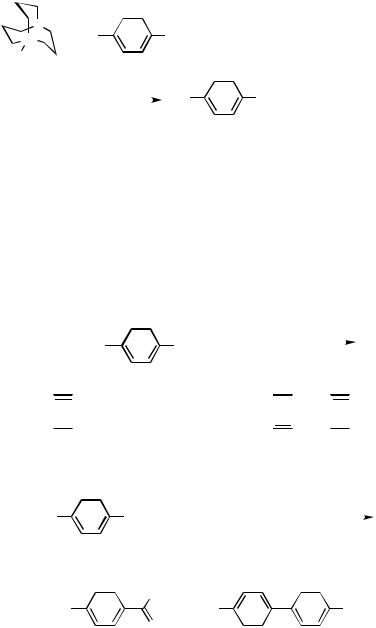
302 |
III Pd-CATALYZED CROSS-COUPLING |
An alkyl, allyl, aryl, or alkynyl group on germanium in addition to an alkenyl group was applicable to the cross-coupling reaction with an aryl bromide (Scheme 37).[43] Kosugi and co-workers used organogermanes having a nucleophilic nitrogen activating center, which assists the transmetallation by nucleophilic coordination to germanium.
|
|
|
|
|
|
|
|
R |
Yield (%) |
||
N |
|
|
|
|
|
|
|
|
|
|
|
|
|
|
|
|
|
|
n-Bu |
8 |
|||
+ Br |
Me |
|
|
||||||||
Ge |
|
|
|||||||||
|
|
allyl |
88 |
||||||||
R |
|
|
|
|
|
|
|
||||
|
|
|
|
|
|
|
Ph |
95 |
|||
|
|
|
|
|
|
|
|
||||
1% Pd3(dba)3 • CHCl3 |
|
|
|
vinyl |
82 |
||||||
4% PPh3, P(o-tol)3 or PPh(o-tol)2 |
R |
|
Me |
1-EtO-vinyl |
59 |
||||||
THF, 120 °C, 24 h |
|
|
PhC |
|
C |
67 |
|||||
|
|
|
|
||||||||
|
|
|
|
||||||||
|
|
|
|
||||||||
Scheme 37
D. ORGANOCADMIUM COMPOUNDS
Organocadmium compounds also couple with organic halides in the presence of a palladium catalyst. The reaction of arylcadmium chlorides with aryl or alkenyl halides was disclosed by Bumagin et al.[44] (Schemes 38 and 39). Similarly, an alkenylcadmium chloride couples with an alkenyl iodide as reported by Negishi et al.[45] (Scheme 40). Although the cross-coupling products are produced in good yields, homocoupling products derived from both substrates accompany in all cases.
− |
|
|
|
|
1% PdCl2(PPh3)2 |
|
|
|
|
|
|
||||
Ph CdCl |
+ |
I |
|
OMe |
THF−Et2O, 20 |
°C, 15 min |
|
1.5 |
: |
1 |
|
|
|||
|
|
|
|
|
|||
Ph
 OMe + Ph−Ph + MeO
OMe + Ph−Ph + MeO


 OMe
OMe
74% |
|
|
|
|
21% |
24% |
||||||
|
|
|
|
|
Scheme 38 |
|
|
|||||
Me |
|
|
|
CdCl |
+ ClCOAr |
1% PdCl2(PPh3)2 |
|
|
||||
|
|
|
|
|
||||||||
|
|
|
|
|
|
|
|
|
||||
|
|
THF−Et2O, 0−20 |
°C,15−20 h |
|||||||||
|
|
|
|
|
|
|
||||||
|
|
|
|
|
Ar = Ph, 4-NO2-C6H4 |
|
|
|||||
|
|
|
|
Ar |
|
|
|
|
|
|
|
|
Me |
|
|
|
Me |
|
Me |
||||||
|
|
|
|
+ |
|
|||||||
|
|
|
|
O |
|
|
|
|
|
|
|
|
|
|
|
|
|
|
|
|
|
|
|
||
|
56−96% |
|
|
|
|
13−20% |
|
|
||||
Scheme 39
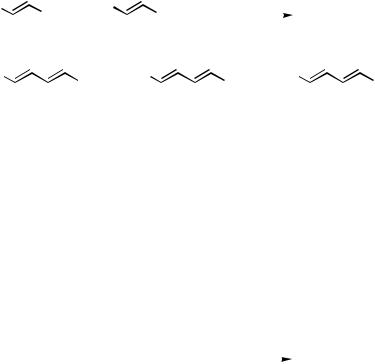
III.2.4 OVERVIEW OF OTHER Pd-CATALYZED CROSS-COUPLING PROTOCOLS |
303 |
||||||||
n-Hex |
CdCl |
+ |
I |
n-Bu |
5% Pd(PPh3)4 |
|
|
|
|
|
|
|
|
|
|
|
|||
|
|
|
THF, 21−23 |
°C, 1 h |
|
||||
|
1.5 : 1 |
|
|
|
|||||
|
|
|
|
|
|
|
|
||
n-Hex |
|
n-Bu |
+ |
n-Hex |
+ |
n-Bu |
|
||
|
|
|
|
n-Hex |
|
|
n-Bu |
|
|
|
86% |
|
|
17% |
|
8% |
|
||
Scheme 40
E. ORGANOINDIUM COMPOUNDS
The Pd-catalyzed cross-coupling reaction of organoindium compounds was first reported in 1999.[46] The reaction was applied to triaryl-, trialkenyland trialkynylindiums, which coupled with aryl iodides, aryl triflates, or alkenyl triflates in high yields (Scheme 41). It is noteworthy that all of the organic groups on indium can participate in the coupling reaction.
|
|
|
|
|
3% PdCl2(PPh3)2 or |
|
|
|
|
R13In + |
− |
PdCl2(dppf) |
R1−R2 |
||
|
|
|
|
||||
|
|
X R2 |
THF, reflux, 0.5−7 h |
||||
|
|
|
|
|
|
||
|
1 |
: |
3 |
|
|
89−97% |
|
|
|
|
|
|
|
|
|
R1 = Ph |
|
|
4-Me-C6H4-I |
|
|
|
|
CH2 |
|
CH |
4-Ac-C6H4-OTf |
|
|||
|
|
||||||
|
|
||||||
PhC |
|
C |
4-t-Bu-1-cyclohexen-1-yl-OTf |
|
|||
|
|
||||||
|
|
||||||
|
|
||||||
TMSC  C n-Bu
C n-Bu
Me cyclopropyl
Scheme 41
F. ORGANOMERCURY COMPOUNDS
There have been many reports on the cross-coupling reaction of organomercury compounds, although their toxicity results in limited synthetic applications. Takagi and coworkers[47] reported the Pd-catalyzed reaction of dialkyland diphenylmercury with acyl halides (Scheme 42). Additional examples of this particular combination of substrates in addition to a carbonylative cross-coupling were reported later by Bumagin et al.[44],[48] (Schemes 43 and 44). The coupling reaction of organomercury compounds as applied also for the synthesis of biaryls (Scheme 45)[49],[50] and conjugated dienes (Scheme 46).[45]
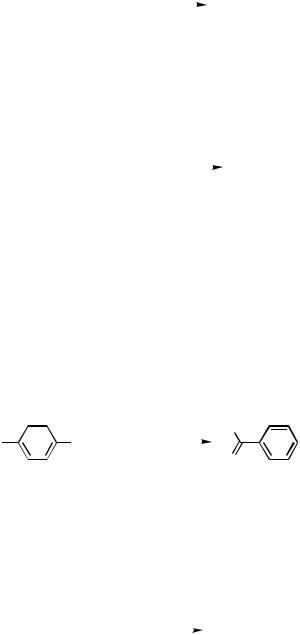
304 |
III |
Pd-CATALYZED CROSS-COUPLING |
|
|
||
|
|
2−13% Pd(PPh3)4 |
|
R1−R1 |
||
|
|
R12Hg + BrCOR2 |
|
|
R1COR2 + |
|
|
|
|
||||
|
|
HMPA, 0−60 °C, 0.5−12 h |
|
|
||
|
R1 |
= Et, Ph R2 = Ph, n-Bu |
34−86% |
<30% |
||
|
|
|
||||
Scheme 42
|
|
|
|
|
|
|
1% PdCl2(MeCN)2, |
|||||||
|
|
|
|
|
|
|
4-NO2-C6H4PdI(PPh3)2 or |
|||||||
R12Hg |
|
|
|
|
|
PhPdI(PPh3)2 |
||||||||
|
|
|
|
|
NaI or n-Bu4NI (4 equiv) |
|||||||||
|
or |
+ BrCOR |
3 |
|
|
|
|
|
|
|
||||
|
|
|
|
|
|
|
|
|||||||
2 |
−HgI |
THF−Et2O, acetone or benzene |
||||||||||||
|
|
|
|
|||||||||||
R |
|
|
|
|
0−20 °C, 5−60 min |
|||||||||
R1 = 2-thienyl |
R3 = |
4-NO |
-C |
H |
4 |
|
|
|||||||
|
|
|
|
|
|
2 |
6 |
|
|
|
||||
Ph |
|
|
|
|
|
2-furyl |
|
|
|
|
||||
5-Me-2-thienyl |
|
|
Ph |
|
|
|
|
|
|
|||||
|
|
|
|
|
|
3-py |
|
|
|
|
|
|
||
R2 = 4-Me-C6H4 |
|
|
|
|
|
|
|
|
|
|
||||
Me |
|
|
|
|
|
|
|
|
|
|
|
|
||
n-Pr |
|
|
|
|
|
|
|
|
|
|
|
|
||
|
|
|
|
|
|
|
|
Scheme 43 |
||||||
|
|
|
|
|
|
|
|
|
1% PdCl2(MeCN)2 |
|||||
|
|
|
|
|
|
|
|
|
CO (1 atm) |
|||||
R1−HgI + I |
|
|
|
|
R2 |
|
n-Bu4NI (4 equiv) |
|
||||||
|
|
|
|
|
||||||||||
|
|
|
|
|
HMPA, 20 °C, 1.5−10 h |
|||||||||
|
|
|
|
|
|
|
|
|
||||||
R1 = Me, n-Pr |
R2 = |
4-Me-C6H4 |
|
|
|
|
||||||||
|
|
|
|
Me |
|
|
|
|
|
|
|
|
||
|
|
|
|
n-Pr |
|
|
|
|
|
|
||||
R1COR3
or + R1−R1 R2COR3
70−100% <20%
R1
 R2
R2
O
60−85%
|
|
|
Scheme 44 |
|
||
|
|
1% 4-NO2-C6H4PdI(PPh3)2 |
|
|||
|
|
CO (1 atm) |
|
|||
|
|
NaI (2 equiv) |
R1–R2 + R1−R1 |
|||
R12Hg + I–R2 |
|
|
|
|||
DMF, 20−90 °C, 10−120 h |
||||||
|
|
|
||||
R1 = 2-thienyl |
R2 = |
4-NO2-C6H4 |
60−95% <20% |
|||
5-Me-2-thienyl |
|
|
2-py |
|
||
|
|
|
2-thienyl |
|
||
|
|
|
2-NO2-3-py |
|
||
Scheme 45
